Brexit anniversary: a long and turbulent year in Scotland
- Published
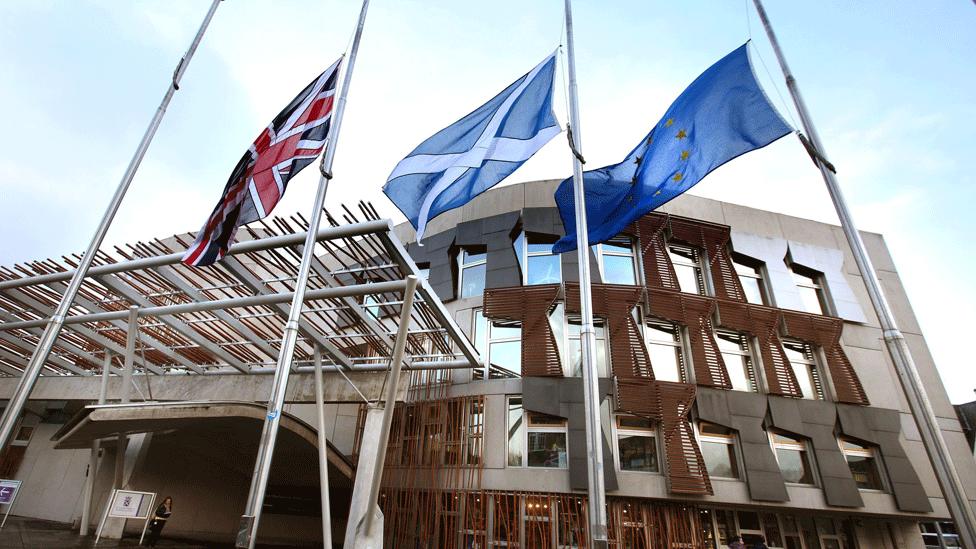
It's been a big year for Scotland's relationship with both the UK and the EU
If a week is a long time in politics, then a year is more like a lifetime. But that's how long it's been since the EU referendum.
One year ago today, we went to the polls. This is not an unusual occurrence in Scotland; it happens roughly once every five months, lately.
This was a biggie, though. People across the UK voted on the country's future relationship with the European Union - and the result threw the nation's politics into outright turmoil.
Consider what has changed over the past 365 days.
David Cameron has been replaced by Theresa May - and George Osborne has gone from being a rather dour Chancellor to a newspaper editor who gleefully bashes the government.
A second Scottish independence referendum has gone from being off the table for a generation, to being "highly likely", to being up in the air amid a "period of reflection".
Mrs May has gone from Home Secretary to Prime Minister to lame duck. All of the ups and downs of a political career, stuffed into 12 months.
What on earth happened?

The referendum

Nigel Farage was quite chuffed about the result, despite having earlier conceded defeat on Twitter
The referendum campaign was, in hindsight, spectacularly bad-tempered. The Remain and Leave camps traded wild allegations, painting apocalyptic visions of the horrors that a win for their opponents could inflict on society.
It got to the point where David Cameron actually warned of World War Three, and even arch-Leaver Michael Gove disowned a poster campaign screeching about the UK being at "breaking point".
Meanwhile the UK's current party leaders - Theresa May and Jeremy Corbyn - were more or less invisible.
In Scotland, just about every elected politician backed Remain, with the exception of UKIP MEP David Coburn and a handful of Conservative MSPs. Domestic rivals Ruth Davidson and Nicola Sturgeon found themselves on the same side on the UK stage, becoming prominent figures in the campaign.
When the talking finally stopped and voters went to the ballot boxes, things panned out differently on opposite sides of Gretna.
Voters in Scotland backed Remain, by 62% to 38%. Voters UK-wide plumped for Leave, by 52% to 48%.
There were, as always, rollercoaster twists along the way. Nigel Farage conceded defeat shortly after polls closed, retracted that in the wee hours, and then declared victory by dawn.
But when the dust settled, the die had been cast: the UK was on its way out of the European Union. And that was just the beginning of it.

Westminster
EU vote: David Cameron says the UK "needs fresh leadership"
In the immediate aftermath of the referendum, the Westminster establishment basically went home for the weekend - and some of them didn't come back. The Leave campaign meanwhile went to the pub.
There was a weird moment of political vacuum, where commentators sat and shrugged at each other (while penning customarily hysterical hot-takes).
David Cameron walked away from Downing Street and right out of the national consciousness. He has barely been seen since.
And who replaced him at the top of the Tory party? After a short but spectacular bout of infighting, Theresa May stood triumphant.
The new prime minister seemed unassailable. Her personal popularity ratings were sky-high. Newspapers compared her to Margaret Thatcher at the peak of her "Iron Lady" pomp. She positively relished her weekly clashes with Jeremy Corbyn, with the SNP's Angus Robertson frequently proving the biggest fly in the parliamentary ointment. In short, all appeared fairly rosy in the world of Theresa May.
And then she ruined it all by calling an election.
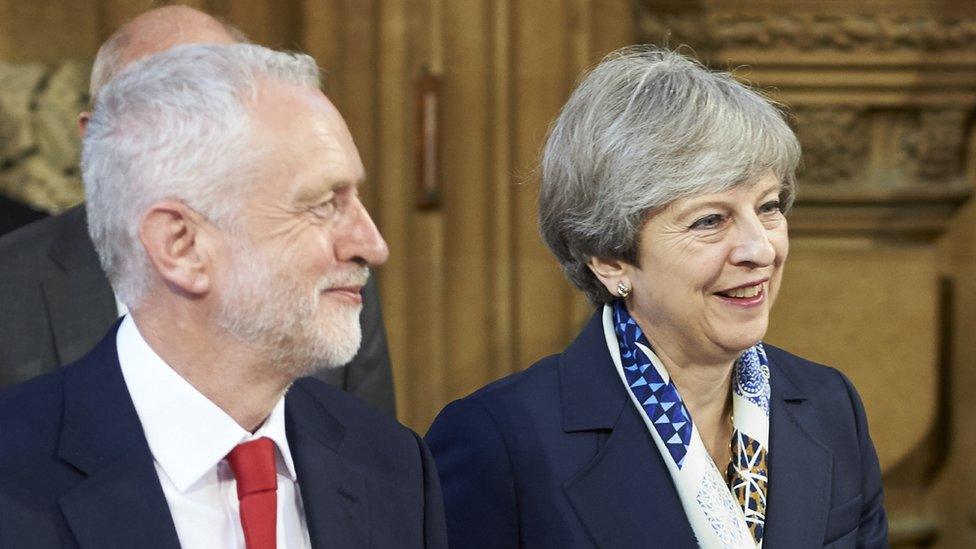
Jeremy Corbyn and Theresa May have both had ups and downs since the referendum
Because when it came down to it, it seemed like the more the voting public saw of Theresa "strong and stable" May, the less they liked. She was an awkward campaigner, who was accused of avoiding the general populace altogether while relying on vapid catchphrases.
The opposite seemed to be true for the resurgent Mr Corbyn, who had previously seemed more a figure of fun than a future prime minister. He had earlier secured his position as party leader in a second contest, but was plagued by a rebellious parliamentary party and constant talk of division.
In the end, neither Labour nor the Tories really won the election. It was a score draw at best, although somehow it was Mr Corbyn's troops who seemed happier with the outcome despite coming second.
The binary referendum seems to have coalesced Westminster into a two-party contest again. Between them, Labour and the Tories won more than 80% of the vote. The Lib Dem fightback failed to materialise, and UKIP disappeared entirely.
This matched the pre-referendum expectation of what would happen in Scotland: a series of two-horse races, punctuated by dodgy bar charts claiming that "only X can beat Y here". Binary constitutional politics.
But as usual, reality sheared off from expectation. Suddenly it seems like there's a multi-party race north of the border again.

Scotland's Place in Europe
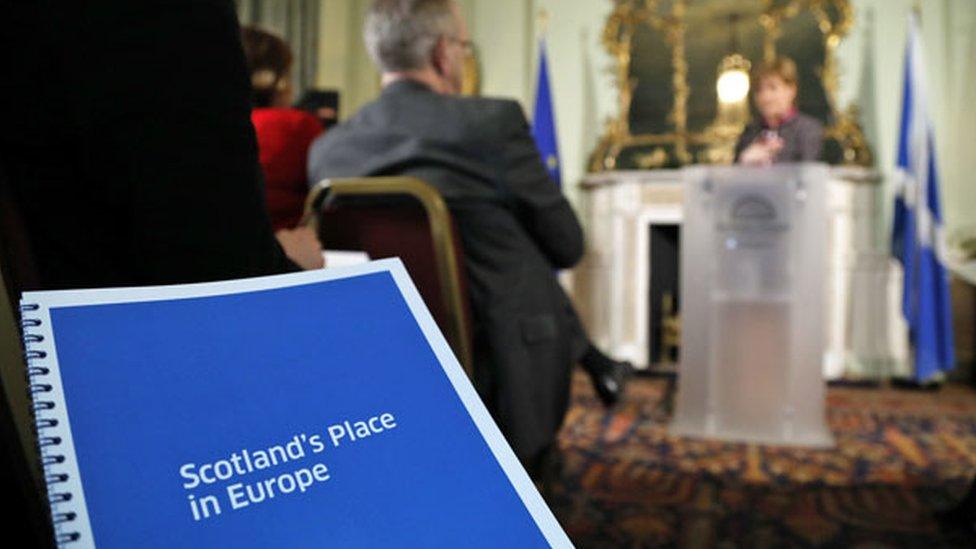
Nicola Sturgeon set out the paper of options at Bute House in December 2016
The referendum may have been a UK-wide affair, but it had huge implications at Holyrood.
Weekly debates about the impact of Brexit were quickly scheduled, leaving little time for any other discussion and parliamentary speechwriters scrambling for thesauruses after week three.
Mike Russell was plucked from the back benches to take up a job with an impossibly long title, which everyone shortened to "Brexit minister". Joan McAlpine's previously overlooked Europe committee became the hottest ticket in town, and gathered evidence from half the country while penning a small library of reports.
And then there's the document which lends this section its name. Nicola Sturgeon's paper of Brexit proposals was aimed at keeping the UK in the single market, or Scotland in the single market, or Scotland in the single market via independence.
The paper was an early triumph simply for existing, at a time when the UK government had no tangible proposals beyond hand-scrawled notes about having cake and eating it.
It was ultimately formally rejected by David Davis on the day Article 50 was triggered, but amid the shifting sands of political intrigue that doesn't really seem to mean anything.
With the election boxing Theresa May into a narrow corner rather than strengthening her hand, the Scottish government consider their proposals very much in play - and they're pushing for a full seat at the table.

Nicola Sturgeon
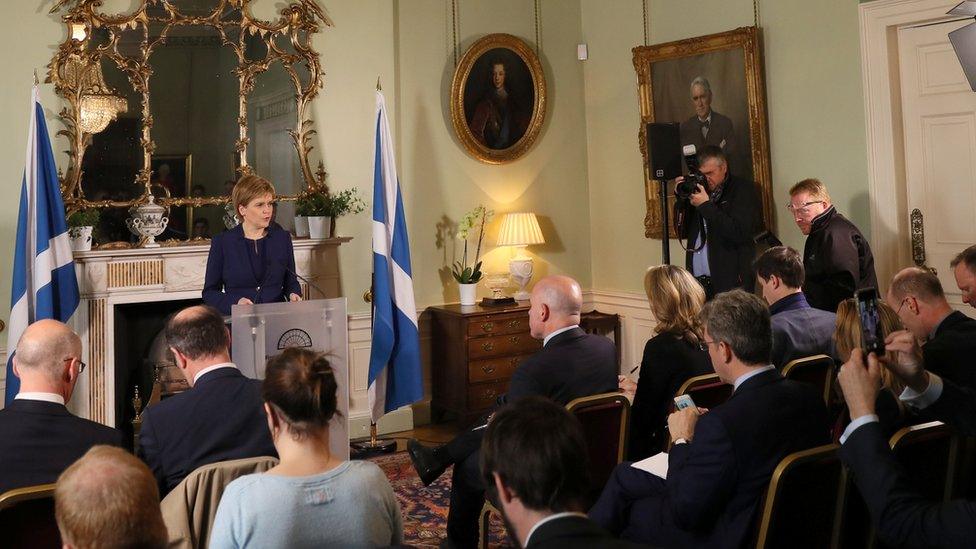
Nicola Sturgeon has given a series of statements at Bute House since the referendum
On the day after the referendum, as David Cameron receded over the horizon and sleep-deprived commentators hacked out tales about a vacuum of power, Nicola Sturgeon alone looked like she had a plan.
The Brexit result had hurt, undoubtedly, but this was a first minister who had already turned one referendum defeat into a personal political tidal wave.
A year on, her plan hasn't exactly come together - but nor has it fallen apart.
In their early exchanges, she and Mrs May circled each other like wary boxers, before exchanging a flurry of blows. Ms Sturgeon gambled first, laying down her cards with "give us a referendum" written across them in bold.
Mrs May hit back with "now is not the time", the first in a string of classic catchphrases ("Brexit means Brexit" a particular hit) which people began to tire of somewhat after the twentieth re-use. The prime minister then proved herself even more of a gambler, by rolling the dice on a snap election.
The election result didn't help either of them. Ms Sturgeon is now "reflecting" on whether her demand cost her party 21 seats, while Mrs May is having to insist that now is not the time for a new PM.
And so the circling continues. We've learned not to dare try to predict anything at all that might happen in politics, but the past year suggests that the May-Sturgeon dynamic will continue to be an explosive one.

The SNP
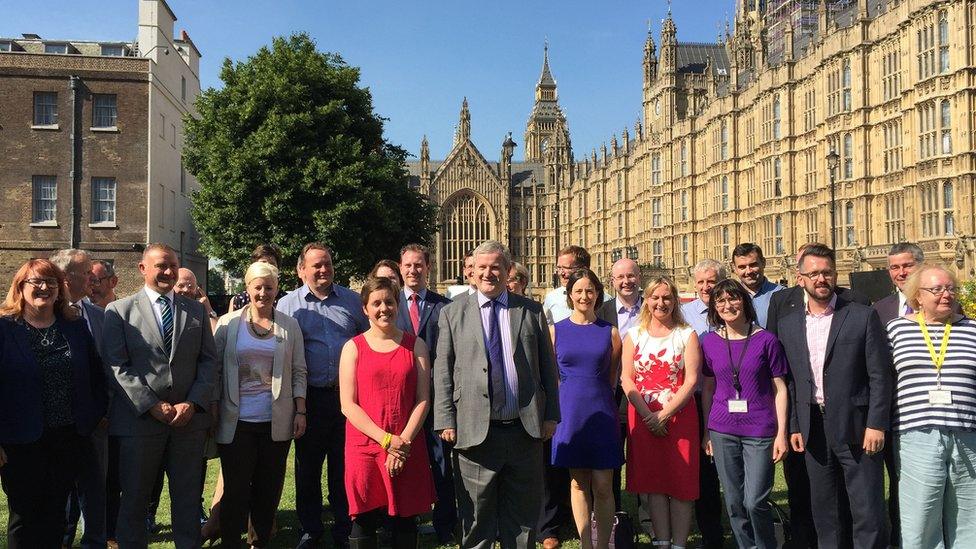
The SNP has had to reinvent its Westminster group, with the leadership team now entirely made up of MPs from the 2015 intake
The aftermath of the referendum and the snap election has been the SNP's first real period of adversity for more than a decade.
Perhaps it's because expectation levels couldn't have got much higher. There was really no way of improving on the 56 MPs returned in 2015, for example - it was an all but unbeatable personal best.
But the party has found itself in the recently uncharacteristic position of being on the back foot, very much on the defensive.
The referendum provided them a decent platform, as one of the most vocally pro-Europe parties around. But the referendum result has not translated into any kind of bounce in support for independence.
Angus Robertson had been emerging as Mrs May's principal irritant at PMQs. Now he has to watch it on TV along with 20 of his fellow dethroned members.
Realistically, the SNP knew it would lose a few seats in the election, simply by dint of political gravity. But they had not suspected the losses on 8 June would be so severe.
Neither did their opponents, all of whom took seats they had not really expected to - in fact both Labour and the Lib Dems gained two seats apiece in constituencies where they actually lost votes on 2015.
The party has responded with a changing of the guard at Westminster. With Mr Robertson gone, Ian Blackford is now the leader - and his entire frontbench team is made up of MPs from the 2015 intake.

Ruth Davidson
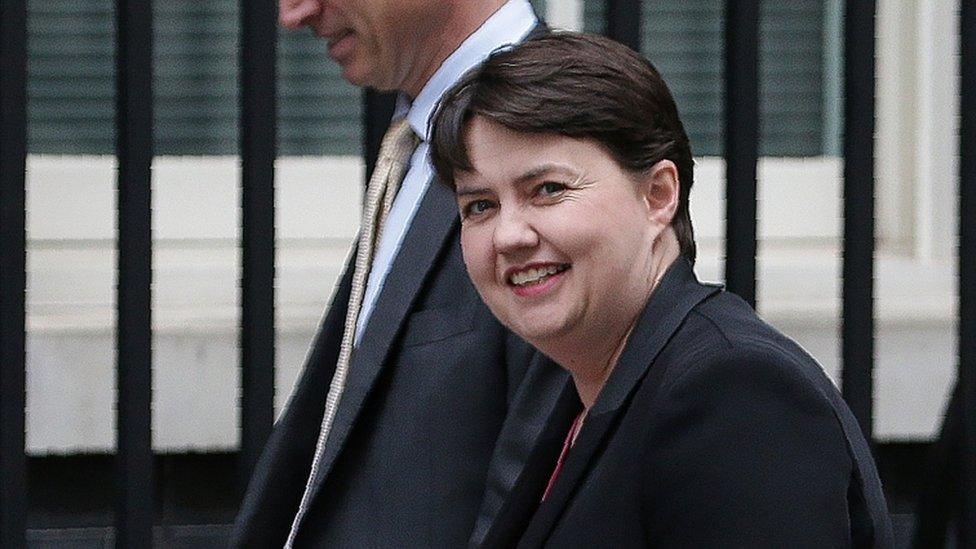
Ms Davidson has been in a position of increased influence since the snap election
The Scottish Conservative leader is one of a handful of people at the peak of politics who might look back on the past 12 months and reflect on more ups than downs.
Starting from the lower end, she lost the EU referendum. Ms Davidson was a major player in the Remain campaign by the end, butting heads with Boris Johnson in the big TV debate.
She has also faced some struggles on the domestic front, the most uncomfortable of which was her duty to defend the UK government's two-child cap on tax credits and the resulting "rape clause" exemption.
But on the up side, she has also had two big electoral successes, guiding the once-toxic Tories firmly into second place in Scottish politics. First in the council elections, where she gained more than 160 seats, and then the general election.
In the latter Ms Davidson's troops arguably saved Mrs May's bacon, with their 12 gains making it possible for her to stretch for a minority government via the DUP.
This has given Ms Davidson influence which she has not been shy about wielding, swanning triumphantly into a Cabinet meeting and advocating an "open" Brexit.

Scottish Labour
![Kezia Dugdale and Jeremy Corbyn [centre of picture] campaigned together](https://ichef.bbci.co.uk/ace/standard/976/cpsprodpb/D74B/production/_90751155_leaders_ap.gif)
Kezia Dugdale and Jeremy Corbyn haven't always been the best of chums but seem to be on the same page now
This has been the year in which Scottish Labour finally found a silver lining amid the clouds.
They started from a very low base, having just been beaten into third place by the Tories in the Holyrood elections. The EU referendum just piled on more misery.
It was to get worse for Kezia Dugdale, who briefly went to America to pitch in with the Clinton campaign and launched "Scotland for Hillary". You can supply your own punchline to that one.
The council elections proved another depressing electoral outing for Labour, with the Tories again in second behind the SNP and Ms Dugdale having to sack her entire Aberdeen City Council group for doing an unauthorised deal.
But things turned around a bit in the general election. Labour not only held on to their single prior seat, they gained six more. Several of which they didn't really expect to.
Ms Dugdale may have backed Owen Smith - remember him? - in the Labour Party's seemingly annual leadership contest, but with Jeremy Corbyn's position cemented post-election the two seem to have made up.
The duo now have a bit of momentum behind them - Ms Dugdale has actually gone so far as to call for another election, external, a sign of how radically different things are in the red corner compared to this time last year.

What next?
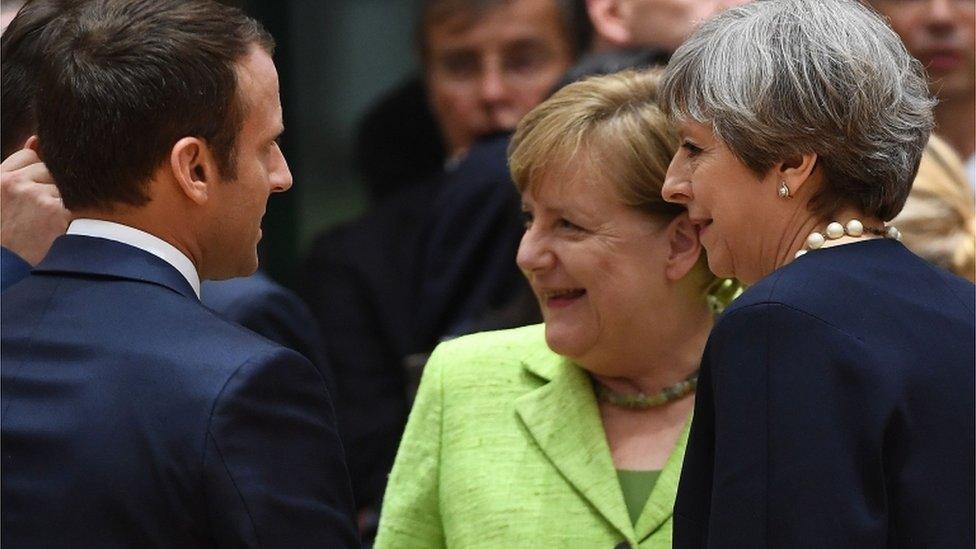
"So...been up to much, Theresa?"
The election result rather sums up the general state of UK politics, both constitutional and domestic, at the moment. It's all at sea.
It was an election with no real winners.
The Tories won the most seats, yes. But rather than increasing their majority, they obliterated it. Labour defied all expectations and left some commentators literally eating their words, external, but didn't come anywhere near government. The SNP won the most seats in Scotland again, but lost 21 MPs, including Angus Robertson and Alex Salmond.
What does it mean for Brexit? One year on from the referendum, things appear more uncertain than ever. It hasn't been a banner year for "strong and stable" politics.
It's hard to imagine what exactly was going though the heads of EU leaders while this was all unfolding, but it's fair to say they probably haven't been overawed by the cool, collected fashion in which the UK's political establishment has handled the past 12 months.
The secession talks have begun, and the Tories haven't even managed to strike a deal to rule even as a minority. If 10 DUP MPs are proving a significant roadblock, then unpicking an endlessly complicated relationship and getting the result signed off by 27 sovereign states could prove a monumental challenge.
It's traditional to close out these retrospective pieces with a look ahead to what comes next, a bit of a prediction. Well, you can't have one. If we can take any lesson from the 12 months that have just passed, it's that just about anything could happen.